堆肥质量标准
- 格式:pdf
- 大小:115.35 KB
- 文档页数:43
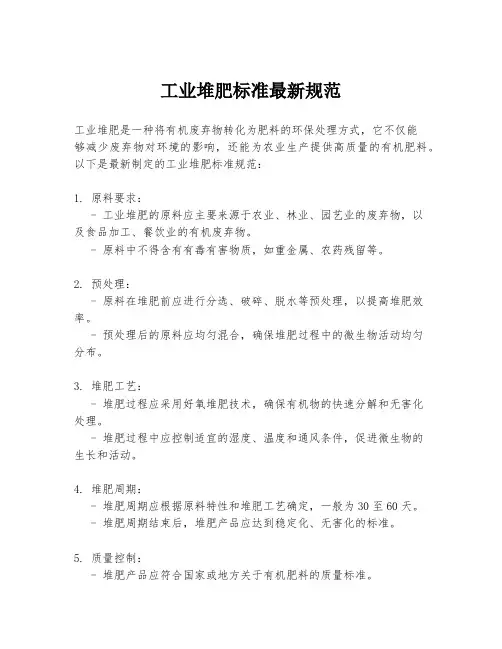
工业堆肥标准最新规范工业堆肥是一种将有机废弃物转化为肥料的环保处理方式,它不仅能够减少废弃物对环境的影响,还能为农业生产提供高质量的有机肥料。
以下是最新制定的工业堆肥标准规范:1. 原料要求:- 工业堆肥的原料应主要来源于农业、林业、园艺业的废弃物,以及食品加工、餐饮业的有机废弃物。
- 原料中不得含有有毒有害物质,如重金属、农药残留等。
2. 预处理:- 原料在堆肥前应进行分选、破碎、脱水等预处理,以提高堆肥效率。
- 预处理后的原料应均匀混合,确保堆肥过程中的微生物活动均匀分布。
3. 堆肥工艺:- 堆肥过程应采用好氧堆肥技术,确保有机物的快速分解和无害化处理。
- 堆肥过程中应控制适宜的湿度、温度和通风条件,促进微生物的生长和活动。
4. 堆肥周期:- 堆肥周期应根据原料特性和堆肥工艺确定,一般为30至60天。
- 堆肥周期结束后,堆肥产品应达到稳定化、无害化的标准。
5. 质量控制:- 堆肥产品应符合国家或地方关于有机肥料的质量标准。
- 堆肥产品中有机物含量、氮、磷、钾等主要养分含量应达到规定标准。
6. 安全与环保:- 堆肥过程中应采取有效措施,防止恶臭、污水和有害气体的排放。
- 堆肥设施应符合环保要求,配备必要的污染控制设施。
7. 产品包装与标识:- 堆肥产品应使用密封、防潮的包装材料进行包装。
- 包装上应明确标注产品名称、成分、使用范围、生产日期、有效期等信息。
8. 储存与运输:- 堆肥产品应在干燥、通风、避光的条件下储存。
- 运输过程中应避免污染和损坏,确保产品安全到达目的地。
9. 监管与认证:- 工业堆肥企业应定期接受环保部门的监督检查。
- 堆肥产品应通过相关认证,以证明其质量和安全性。
10. 用户指导:- 提供详细的使用指南,指导用户正确使用堆肥产品,以发挥其最佳效果。
通过遵循这些规范,工业堆肥不仅能达到环保和资源循环利用的目的,还能确保最终产品的质量,为农业生产提供支持。
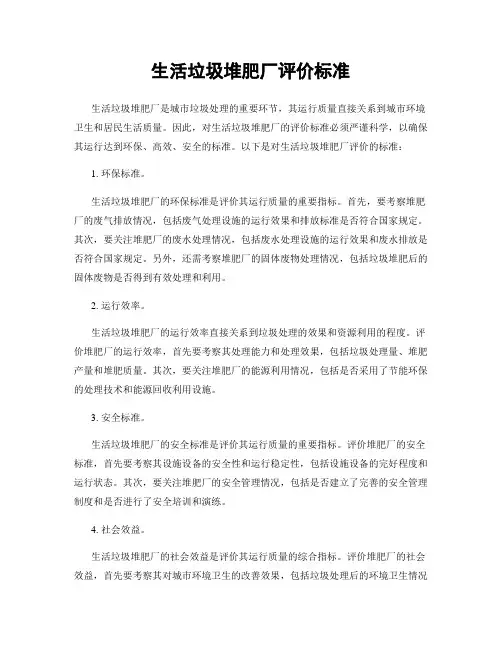
生活垃圾堆肥厂评价标准生活垃圾堆肥厂是城市垃圾处理的重要环节,其运行质量直接关系到城市环境卫生和居民生活质量。
因此,对生活垃圾堆肥厂的评价标准必须严谨科学,以确保其运行达到环保、高效、安全的标准。
以下是对生活垃圾堆肥厂评价的标准:1. 环保标准。
生活垃圾堆肥厂的环保标准是评价其运行质量的重要指标。
首先,要考察堆肥厂的废气排放情况,包括废气处理设施的运行效果和排放标准是否符合国家规定。
其次,要关注堆肥厂的废水处理情况,包括废水处理设施的运行效果和废水排放是否符合国家规定。
另外,还需考察堆肥厂的固体废物处理情况,包括垃圾堆肥后的固体废物是否得到有效处理和利用。
2. 运行效率。
生活垃圾堆肥厂的运行效率直接关系到垃圾处理的效果和资源利用的程度。
评价堆肥厂的运行效率,首先要考察其处理能力和处理效果,包括垃圾处理量、堆肥产量和堆肥质量。
其次,要关注堆肥厂的能源利用情况,包括是否采用了节能环保的处理技术和能源回收利用设施。
3. 安全标准。
生活垃圾堆肥厂的安全标准是评价其运行质量的重要指标。
评价堆肥厂的安全标准,首先要考察其设施设备的安全性和运行稳定性,包括设施设备的完好程度和运行状态。
其次,要关注堆肥厂的安全管理情况,包括是否建立了完善的安全管理制度和是否进行了安全培训和演练。
4. 社会效益。
生活垃圾堆肥厂的社会效益是评价其运行质量的综合指标。
评价堆肥厂的社会效益,首先要考察其对城市环境卫生的改善效果,包括垃圾处理后的环境卫生情况和居民生活质量的提升效果。
其次,要关注堆肥厂对当地经济的促进作用,包括是否带动了相关产业的发展和创造了就业机会。
综上所述,生活垃圾堆肥厂的评价标准应包括环保标准、运行效率、安全标准和社会效益等方面,以全面评价其运行质量。
只有严格按照科学的标准评价生活垃圾堆肥厂,才能确保其达到环保、高效、安全的运行标准,为城市环境卫生和居民生活质量提供有力支持。

高温堆肥的卫生标准
高温堆肥是一种将有机废物进行分解处理的方法,通过控制温度在50-65摄氏度以上,利用微生物的作用将有机废物转化为
肥料。
由于高温能够杀死绝大部分病菌和有害生物,因此高温堆肥具有较高的卫生标准。
以下是高温堆肥的卫生标准:
1. 温度控制:高温堆肥的核心是控制堆肥温度在50-65摄氏度
以上,持续一定的时间,以确保有害微生物和病菌被有效杀死。
2. 堆肥时间:堆肥时间应根据不同的有机废物类型和堆肥系统进行设定,通常要求达到一定的时间,以确保充分分解和熟化。
3. 堆肥料理:高温堆肥中,堆肥料应当经过适当的翻堆和混合,确保废物在整个堆肥过程中充分接触氧气和微生物,有效分解。
4. 氧气供应:高温堆肥需要充足的氧气供应,以促进有机物的分解和微生物的正常生长活动。
5. 过程监控:对于高温堆肥,应进行过程监控,监测堆肥温度、堆肥料理、杂质等参数,确保堆肥过程的正常进行。
6. 臭味控制:高温堆肥由于有机物的分解会产生氨气等副产物,应采取相应的措施控制臭味扩散,减少对周边环境和人群的影响。
7. 产品质量检测:高温堆肥成品应进行产品质量检测,包括有机质含量、微生物指标、金属重金属含量等,确保产品符合相关标准和要求。
需要注意的是,高温堆肥的卫生标准可能会因国家和地区的规定、堆肥工艺和用途等而有所不同,因此在具体实施过程中应参照相关标准和指南进行操作。
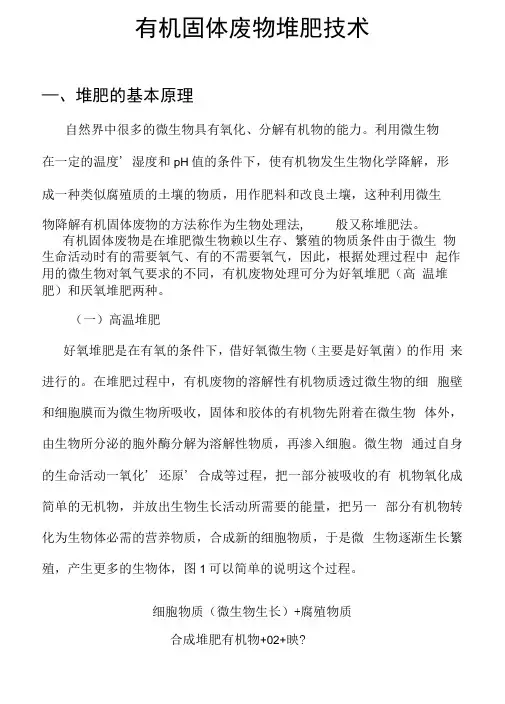
有机固体废物堆肥技术—、堆肥的基本原理自然界中很多的微生物具有氧化、分解有机物的能力。
利用微生物在一定的温度' 湿度和pH值的条件下,使有机物发生生物化学降解,形成一种类似腐殖质的土壤的物质,用作肥料和改良土壤,这种利用微生物降解有机固体废物的方法称作为生物处理法, 般又称堆肥法。
有机固体废物是在堆肥微生物赖以生存、繁殖的物质条件由于微生物生命活动时有的需要氧气、有的不需要氧气,因此,根据处理过程中起作用的微生物对氧气要求的不同,有机废物处理可分为好氧堆肥(高温堆肥)和厌氧堆肥两种。
(一)高温堆肥好氧堆肥是在有氧的条件下,借好氧微生物(主要是好氧菌)的作用来进行的。
在堆肥过程中,有机废物的溶解性有机物质透过微生物的细胞壁和细胞膜而为微生物所吸收,固体和胶体的有机物先附着在微生物体外,由生物所分泌的胞外酶分解为溶解性物质,再渗入细胞。
微生物通过自身的生命活动一氧化' 还原' 合成等过程,把一部分被吸收的有机物氧化成简单的无机物,并放出生物生长活动所需要的能量,把另一部分有机物转化为生物体必需的营养物质,合成新的细胞物质,于是微生物逐渐生长繁殖,产生更多的生物体,图1可以简单的说明这个过程。
细胞物质(微生物生长)+腐殖物质合成堆肥有机物+02+映?CO?、H?。
?、NH" P02» SQ2-4+ 能力排入环境释放的能量转化成热图1堆肥的好氧堆肥的过程图堆肥有四个阶段组成:升温阶段' 高温阶段、降温阶段、和腐熟阶段。
每个阶段的微生物种类是不同的。
(二)厌氧堆肥厌氧堆肥是在五氧条件下,借厌氧微生物(主要是厌氧菌)的作用来进行的,图2简单说明了有机物的厌氧分解过程。
从图2可看出,当有机物厌氧分解时,主要经历两个阶段:酸性发酵阶段个碱性发酵阶段(或称产甲烷阶段)。
图2有机物厌氧堆肥分解厂细胞物质堆肥有机物+微晶厂细胞物质有机酸+微生物、COT-NH3、H2S、PH3 等+能量C02、CH4+能用)二、堆肥工艺流程(一)堆肥工艺程序传统堆肥化技术采用厌氧的堆积法。
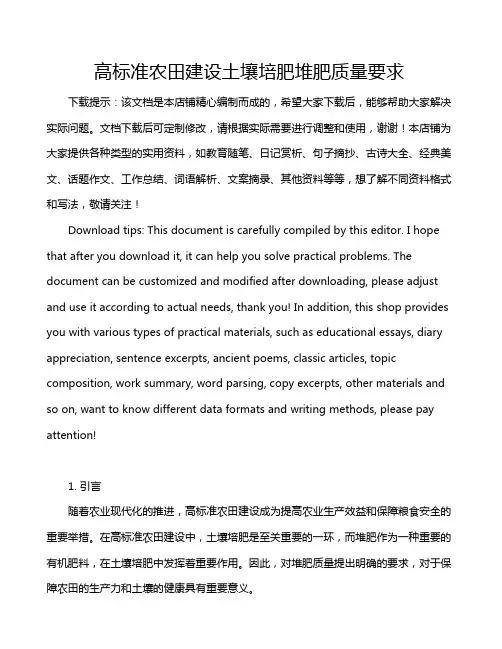
高标准农田建设土壤培肥堆肥质量要求下载提示:该文档是本店铺精心编制而成的,希望大家下载后,能够帮助大家解决实际问题。
文档下载后可定制修改,请根据实际需要进行调整和使用,谢谢!本店铺为大家提供各种类型的实用资料,如教育随笔、日记赏析、句子摘抄、古诗大全、经典美文、话题作文、工作总结、词语解析、文案摘录、其他资料等等,想了解不同资料格式和写法,敬请关注!Download tips: This document is carefully compiled by this editor. I hope that after you download it, it can help you solve practical problems. The document can be customized and modified after downloading, please adjust and use it according to actual needs, thank you! In addition, this shop provides you with various types of practical materials, such as educational essays, diary appreciation, sentence excerpts, ancient poems, classic articles, topic composition, work summary, word parsing, copy excerpts, other materials and so on, want to know different data formats and writing methods, please pay attention!1. 引言随着农业现代化的推进,高标准农田建设成为提高农业生产效益和保障粮食安全的重要举措。
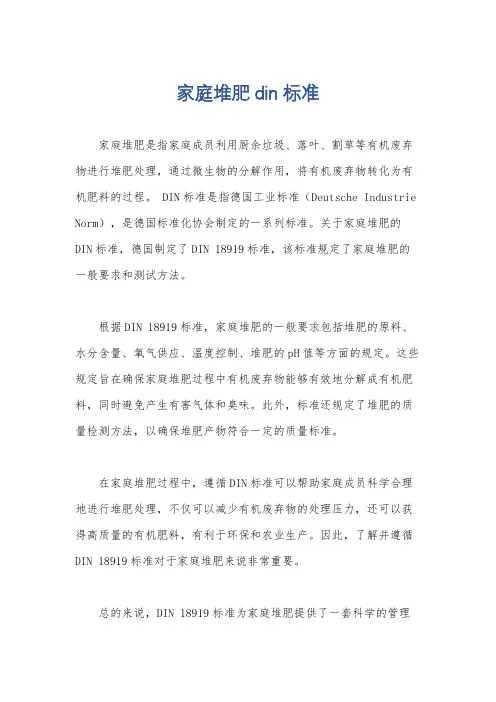
家庭堆肥din标准
家庭堆肥是指家庭成员利用厨余垃圾、落叶、割草等有机废弃物进行堆肥处理,通过微生物的分解作用,将有机废弃物转化为有机肥料的过程。
DIN标准是指德国工业标准(Deutsche Industrie Norm),是德国标准化协会制定的一系列标准。
关于家庭堆肥的DIN标准,德国制定了DIN 18919标准,该标准规定了家庭堆肥的一般要求和测试方法。
根据DIN 18919标准,家庭堆肥的一般要求包括堆肥的原料、水分含量、氧气供应、温度控制、堆肥的pH值等方面的规定。
这些规定旨在确保家庭堆肥过程中有机废弃物能够有效地分解成有机肥料,同时避免产生有害气体和臭味。
此外,标准还规定了堆肥的质量检测方法,以确保堆肥产物符合一定的质量标准。
在家庭堆肥过程中,遵循DIN标准可以帮助家庭成员科学合理地进行堆肥处理,不仅可以减少有机废弃物的处理压力,还可以获得高质量的有机肥料,有利于环保和农业生产。
因此,了解并遵循DIN 18919标准对于家庭堆肥来说非常重要。
总的来说,DIN 18919标准为家庭堆肥提供了一套科学的管理
方法和质量要求,有助于规范家庭堆肥行为,保障有机废弃物的有效处理和资源化利用。

固体有机废物堆肥化设备与技术标准1 范围本规程规定了固体有机废物堆肥化过程中所涉及的生产环境、生产车间、原料预处理、堆肥接种、一次发酵、二次发酵、后处理加工、质量检验等技术环节的要求。
本标准适用于固体有机废物堆肥化过程及堆肥产品。
2 规范性引用文件下列文件中的条款通过本标准的引用而成为本标准的条款。
凡是注日期的引用文件,其随后所有的修改单(不包括勘误的内容)或修订版均不适用于本标准,然而,鼓励根据本标准达成协议的各方研究是否可使用这些文件的最新版本。
凡是不注日期的引用文件,其最新版本适用于本标准。
GB 7959-1987 粪便无害化卫生标准GB14554-1993 恶臭污染物排放标准GB 3095-1996 环境空气质量标准GB3838-2002 地表水质量标准GB18877-2002 有机-无机复混肥料GB 20287-2006 农用微生物菌剂NY525-2002 有机肥料NY/T 7982004复合微生物肥料NY/T 883-2004 农用微生物菌剂生产技术规程NY 884-2004生物有机肥GB 4284-1984农用污泥中污染物控制标准GB 8172-1987城镇垃圾农用控制标准GB12348—1990工业企业厂界噪声标准HJ/T81—2001畜禽养殖业污染防治技术规范GB 18596-2001畜禽养殖业污染物排放标准3 定义本标准采用如下定义3.1 固体有机废物固体有机废物是指在植物和动物生产以及人类生活等过程中产生的对原生产系统或原所有者无原使用价值的生物质类残余物。
包括作物秸秆、畜禽粪便、生活污泥、加工类有机废物、园林修剪废物、生物质垃圾等。
3.2 堆肥化堆肥化是指在一定的水分、C/N比和通风等人工控制条件下,通过微生物的作用,实现固体有机废物无害化、稳定化的过程。
堆肥化的产物称为堆肥。
堆肥化是一种有机肥料生产方式,也是一种固体废物的生物处理方式。
3.3 堆肥接种剂堆肥接种剂是指能加速固体有机废物堆肥化进程的微生物活体制剂。
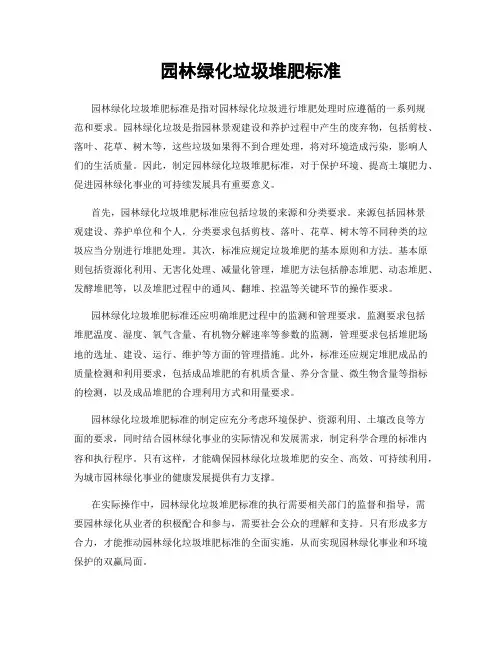
园林绿化垃圾堆肥标准园林绿化垃圾堆肥标准是指对园林绿化垃圾进行堆肥处理时应遵循的一系列规范和要求。
园林绿化垃圾是指园林景观建设和养护过程中产生的废弃物,包括剪枝、落叶、花草、树木等,这些垃圾如果得不到合理处理,将对环境造成污染,影响人们的生活质量。
因此,制定园林绿化垃圾堆肥标准,对于保护环境、提高土壤肥力、促进园林绿化事业的可持续发展具有重要意义。
首先,园林绿化垃圾堆肥标准应包括垃圾的来源和分类要求。
来源包括园林景观建设、养护单位和个人,分类要求包括剪枝、落叶、花草、树木等不同种类的垃圾应当分别进行堆肥处理。
其次,标准应规定垃圾堆肥的基本原则和方法。
基本原则包括资源化利用、无害化处理、减量化管理,堆肥方法包括静态堆肥、动态堆肥、发酵堆肥等,以及堆肥过程中的通风、翻堆、控温等关键环节的操作要求。
园林绿化垃圾堆肥标准还应明确堆肥过程中的监测和管理要求。
监测要求包括堆肥温度、湿度、氧气含量、有机物分解速率等参数的监测,管理要求包括堆肥场地的选址、建设、运行、维护等方面的管理措施。
此外,标准还应规定堆肥成品的质量检测和利用要求,包括成品堆肥的有机质含量、养分含量、微生物含量等指标的检测,以及成品堆肥的合理利用方式和用量要求。
园林绿化垃圾堆肥标准的制定应充分考虑环境保护、资源利用、土壤改良等方面的要求,同时结合园林绿化事业的实际情况和发展需求,制定科学合理的标准内容和执行程序。
只有这样,才能确保园林绿化垃圾堆肥的安全、高效、可持续利用,为城市园林绿化事业的健康发展提供有力支撑。
在实际操作中,园林绿化垃圾堆肥标准的执行需要相关部门的监督和指导,需要园林绿化从业者的积极配合和参与,需要社会公众的理解和支持。
只有形成多方合力,才能推动园林绿化垃圾堆肥标准的全面实施,从而实现园林绿化事业和环境保护的双赢局面。
综上所述,园林绿化垃圾堆肥标准是园林绿化事业的重要组成部分,对于推动园林绿化事业的可持续发展,保护环境,改善生活质量具有重要意义。
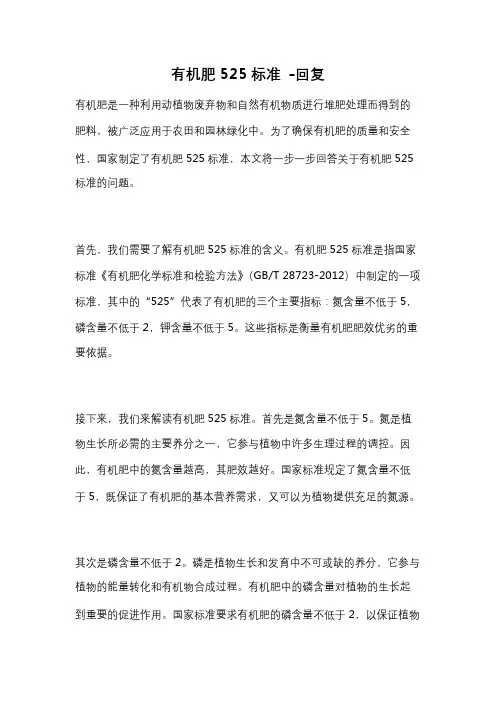
有机肥525标准-回复有机肥是一种利用动植物废弃物和自然有机物质进行堆肥处理而得到的肥料,被广泛应用于农田和园林绿化中。
为了确保有机肥的质量和安全性,国家制定了有机肥525标准,本文将一步一步回答关于有机肥525标准的问题。
首先,我们需要了解有机肥525标准的含义。
有机肥525标准是指国家标准《有机肥化学标准和检验方法》(GB/T 28723-2012)中制定的一项标准,其中的“525”代表了有机肥的三个主要指标:氮含量不低于5,磷含量不低于2,钾含量不低于5。
这些指标是衡量有机肥肥效优劣的重要依据。
接下来,我们来解读有机肥525标准。
首先是氮含量不低于5。
氮是植物生长所必需的主要养分之一,它参与植物中许多生理过程的调控。
因此,有机肥中的氮含量越高,其肥效越好。
国家标准规定了氮含量不低于5,既保证了有机肥的基本营养需求,又可以为植物提供充足的氮源。
其次是磷含量不低于2。
磷是植物生长和发育中不可或缺的养分,它参与植物的能量转化和有机物合成过程。
有机肥中的磷含量对植物的生长起到重要的促进作用。
国家标准要求有机肥的磷含量不低于2,以保证植物在生长发育过程中有足够的磷供应。
最后是钾含量不低于5。
钾是植物生长中的一种重要无机元素,它参与调节植物的渗透调节和抗逆性,提高植物的抗病虫害能力。
有机肥中的钾含量的高低直接影响着植物的生长和产量。
标准要求有机肥的钾含量不低于5,以满足植物对钾的需求。
有机肥525标准的制定对于保障有机肥的质量和安全性起到了至关重要的作用。
通过规定氮、磷、钾等营养元素的最低含量,既保证了有机肥的基本营养需求,又防止了有机肥中有害物质的积累。
那么,如何确保有机肥的质量符合525标准呢?首先,农民和生产者应选择正规的有机肥供应商,确保购买到的有机肥符合国家标准。
其次,有机肥生产企业应建立完善的质量管理体系,确保生产过程中各个环节的质量控制。
同时,应定期抽样检测,对有机肥进行理化指标、微生物指标和重金属指标等全面检测,以保证有机肥的质量符合标准要求。
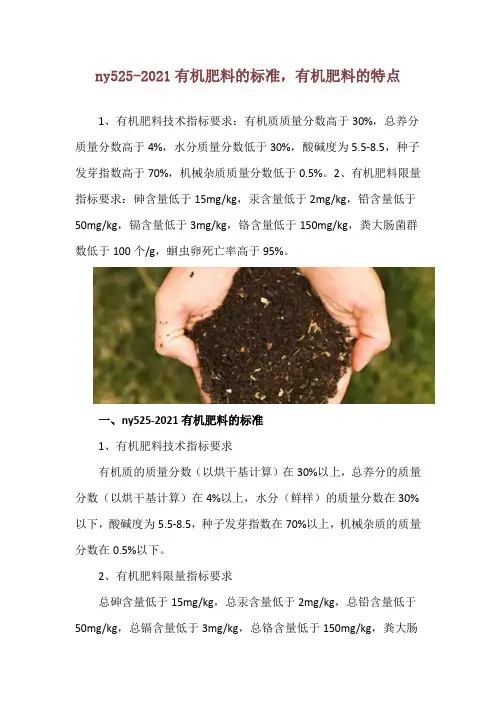
ny525-2021有机肥料的标准,有机肥料的特点1、有机肥料技术指标要求:有机质质量分数高于30%,总养分质量分数高于4%,水分质量分数低于30%,酸碱度为5.5-8.5,种子发芽指数高于70%,机械杂质质量分数低于0.5%。
2、有机肥料限量指标要求:砷含量低于15mg/kg,汞含量低于2mg/kg,铅含量低于50mg/kg,镉含量低于3mg/kg,铬含量低于150mg/kg,粪大肠菌群数低于100个/g,蛔虫卵死亡率高于95%。
一、ny525-2021有机肥料的标准1、有机肥料技术指标要求有机质的质量分数(以烘干基计算)在30%以上,总养分的质量分数(以烘干基计算)在4%以上,水分(鲜样)的质量分数在30%以下,酸碱度为5.5-8.5,种子发芽指数在70%以上,机械杂质的质量分数在0.5%以下。
2、有机肥料限量指标要求总砷含量低于15mg/kg,总汞含量低于2mg/kg,总铅含量低于50mg/kg,总镉含量低于3mg/kg,总铬含量低于150mg/kg,粪大肠菌群数低于100个/g,蛔虫卵死亡率95%以上。
3、有机肥料生产原料适用类目录(1)种植业废弃物:主要包括谷、麦、薯类等作物秸秆,豆类作物秸秆,油料作物秸秆,园艺及其他作物秸秆,林草废弃物。
(2)养殖业废弃物:主要包括禽畜粪尿、禽畜圈舍垫料(植物类)以及废饲料。
(3)加工业废弃物:主要包括麸皮、稻壳、大豆饼、花生饼、菜籽饼、油葵饼、芝麻饼、棉籽饼、茶籽饼等种植业加工过程中的产物。
(4)天然原料:主要包括草炭、泥炭、含腐殖酸的褐煤等。
二、有机肥料的特点1、有机肥料又叫做农家肥料,通常以有机物质(含有碳元素的化合物)作为肥料的均可以称为有机肥料。
常见的有机肥料有厩肥、堆肥、绿肥、饼肥、人粪尿、沼气肥等。
2、有机肥料的特点主要有种类多、来源广、资源丰富、数量大、有机质含量高、营养全面、肥效时间长、后劲足。
3、有机肥料不仅可以为作物生长提供所需养分,还可以保持和提高土壤肥力,改善土壤结构,提高土壤生物活性以及土壤养分的有效性。
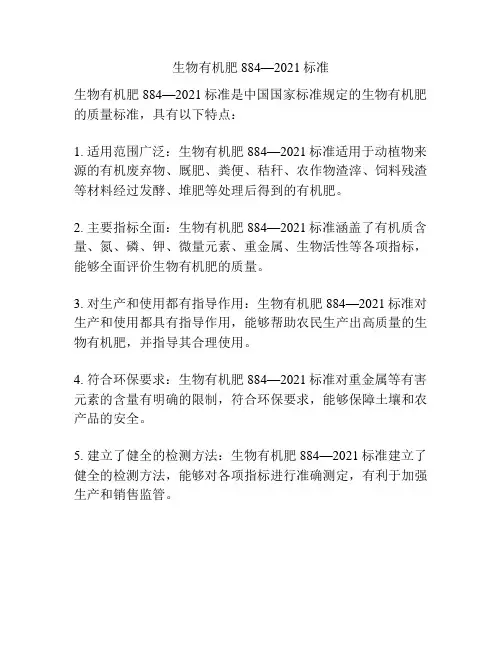
生物有机肥884—2021标准
生物有机肥884—2021标准是中国国家标准规定的生物有机肥的质量标准,具有以下特点:
1. 适用范围广泛:生物有机肥884—2021标准适用于动植物来源的有机废弃物、厩肥、粪便、秸秆、农作物渣滓、饲料残渣等材料经过发酵、堆肥等处理后得到的有机肥。
2. 主要指标全面:生物有机肥884—2021标准涵盖了有机质含量、氮、磷、钾、微量元素、重金属、生物活性等各项指标,能够全面评价生物有机肥的质量。
3. 对生产和使用都有指导作用:生物有机肥884—2021标准对生产和使用都具有指导作用,能够帮助农民生产出高质量的生物有机肥,并指导其合理使用。
4. 符合环保要求:生物有机肥884—2021标准对重金属等有害元素的含量有明确的限制,符合环保要求,能够保障土壤和农产品的安全。
5. 建立了健全的检测方法:生物有机肥884—2021标准建立了健全的检测方法,能够对各项指标进行准确测定,有利于加强生产和销售监管。
有机肥料新标准一、引言有机肥料是一种重要的农业资源,其质量直接关系到农作物的生长和土壤的健康。
为了规范有机肥料的生产和使用,保障农业生产的可持续发展,我国制定了有机肥料新标准。
本文将对有机肥料新标准的各个方面进行详细解读。
二、原料要求1. 有机肥料的主要原料应为动植物残体、畜禽粪便等有机物质。
2. 原料应无恶臭、无有害微生物及病虫害。
3. 禁止使用城市垃圾、工业废弃物等有害物质作为有机肥料原料。
三、外观要求1. 有机肥料应呈均匀的颗粒状或粉状,无结块、无霉变。
2. 颜色应为深褐色或棕色,有光泽。
四、堆肥质量要求1. 有机肥料应经过堆肥处理,充分腐熟。
2. 堆肥过程中应控制温度、湿度和pH值等参数,保证微生物的活性。
3. 堆肥成品应无害虫、无杂草种子、无病原菌。
五、有机质含量要求1. 有机肥料中的有机质含量应不低于30%。
2. 有机质含量越高,说明肥料的质量越好。
六、氮、磷、钾含量要求1. 有机肥料中的氮、磷、钾含量应符合国家标准,以保证肥效。
2. 不同类型的有肥料对氮、磷、钾含量的要求不同,应按照国家标准进行生产和标识。
七、重金属及其他有害物质含量要求1. 有机肥料中的重金属及其他有害物质含量应符合国家标准。
2. 重金属及其他有害物质含量过高会对环境和人体健康造成危害,因此需要严格控制其含量。
八、微生物指标要求1. 有机肥料中的微生物指标应符合国家标准,以保证肥料的质量和安全性。
2. 常见的微生物指标包括菌落总数、大肠菌群等,具体要求应根据不同类型和用途的有机肥料而定。
ICS B13Q/LXKD 秦皇岛领先康地农业技术有限公司企业标准Q/LXKD 02—2019畜禽粪便堆肥Standard for Compost of Animal Manure2019-11-15发布2019-11-15实施目 次前言 (II)1 范围 (1)2 规范性引用文件 (1)3 术语和定义 (2)4 质量要求 (2)5 试验方法 (3)6 检验规则 (5)7 包装、标识、运输和贮存 (5)8 利用 (5)前 言本标准按照GB/T 1.1-2009给出的规则起草。
本标准由秦皇岛领先康地农业技术有限公司提出。
本标准由秦皇岛领先康地农业技术有限公司归口。
本标准起草单位:秦皇岛领先康地农业技术有限公司。
本标准主要起草人:刘洪钧、徐延平、杜蕊、葛振宇、高春阳、杜迎辉、宫锡余、揣峻峰。
本标准为首次发布。
畜禽粪便堆肥1 范围本标准规定了畜禽粪便堆肥的术语和定义、要求、试验方法、检验规则、包装、标识、运输和贮存及利用。
本标准适用于畜禽粪便堆肥。
2 规范性引用文件下列文件中的条款通过本标准的引用而成为本标准的条款。
凡是注日期的引用文件,仅注日期的版本适用于本标准。
凡是不注日期的引用文件,其最新版本(包括所有的修改单)适用于本标准。
GB 18382 肥料标识 内容和要求GB 18877 有机-无机复混肥料GB 7959 粪便无害化卫生要求GB/T 19524.1 肥料中粪大肠菌群的测定GB/T 19524.2 肥料中蛔虫卵死亡率的测定GB/T 6682 分析实验室用水规格和试验方法GB/T 8170 数值修约规则与极限数值的表示和判定GB/T 25246 畜禽粪便还田技术规范GB/T 25171 畜禽养殖废弃物管理术语GB/T 31755 绿化植物废弃物处置和应用技术规程GB/T 36195 畜禽粪便无害化处理技术规范HG/T 2843 化肥产品 化学分析常用标准滴定溶液、标准溶液、试剂溶液和指示剂溶液HJ 497 畜禽养殖业污染治理工程技术规范HJ 615 土壤 有机碳的测定 重铬酸钾氧化-分光光度法HJ 658 土壤 有机碳的测定 燃烧氧化-滴定法HJ 695 土壤 有机碳的测定 燃烧氧化-非分散红外法NY 525 有机肥料NY/T 1978 肥料 汞、砷、镉、铅、铬的测定NY/T 2540 肥料 钾含量的测定NY/T 2541 肥料 磷含量的测定NY/T 2542 肥料 总氮含量的测定NY/T 798 复合微生物肥料NY/T 2876 肥料和土壤调理剂有机质分级测定NY/T 3036 肥料和土壤调理剂 水分含量、粒度、细度的测定NY/T 3161 有机肥料中砷、镉、铬、铅、汞、铜、锰、镍、锌、锶、钴的测定 微波消解-电感耦合等离子体质谱法NY/T 3441 蔬菜废弃物高温堆肥无害化处理技术规程NY/T 3442 畜禽粪便堆肥技术规范3 术语和定义本标准采用下列术语和定义。
有机肥料新标准ny525-2021有机肥料是一种通过去除有害物质、添加微生物等方法生产的,用于增加作物养分和提高土壤质量的肥料。
为了确保有机肥料的质量和安全性,国家发布了新的有机肥料标准NY525-2021,以下是有关标准的一些信息。
1.定义有机肥料是指在有机物质分解过程中,通过控制温度、湿度、氧气等因素而制成的可供作物直接利用的有机养分来源。
2.适用范围该标准适用于用于增加作物养分和改善土壤质量的各种有机肥料,包括畜禽粪便、农作物秸秆、枯枝败叶、食品废弃物、城市固体废弃物等。
3.内容要求(1)有机质含量有机质含量是有机肥料的核心指标。
标准规定,有机质含量应不低于25%,且必须经过严格检测和分析确认。
(2)无害化处理有机肥料必须经过无害化处理,包括发酵、堆肥、腐熟等。
发酵期间需要控制温度、湿度等因素,防止发生恶臭和病原微生物滋生。
(3)微生物群落有机肥料中的微生物群落对作物生长和土壤质量起着重要作用。
标准规定,有机肥料中应含有多种有益微生物,如磷解菌、氮固定菌等。
(4)营养元素含量有机肥料中含有丰富的营养元素,如氮、磷、钾等。
标准规定,有机肥料中氮、磷、钾的含量应符合国家有关标准。
(5)有害物质含量有机肥料中含有一些有害物质,如重金属、农药残留等。
标准规定,有机肥料中有害物质的含量应低于国家有关标准。
(6)包装标识有机肥料的包装标识必须清晰明确,标注产品名称、品牌、生产日期、生产厂家、成分含量、使用方法等。
4.社会意义制定有机肥料新标准,有助于保证有机肥料的质量和安全性,促进我国有机农业的健康发展。
有机肥料具有良好的环境效益和经济效益,可以改善土壤质量、增加作物产量、减少化肥污染等。
同时,有机肥料的生产也提供了就业机会,促进了农业产业结构调整。
总的来说,有机肥料新标准的发布,对于推动我国有机农业的发展,提高我国农业的质量和效益,具有重要的意义。
工业固体废物堆肥工艺一、好氧堆肥的基本工艺传统的堆肥化技术采用厌氧的野外堆积法,使用这种方法占地面积大,时间长。
现代化的堆肥生产一般采用好氧堆肥工艺,它通常由前处理、主发酵(一次发酵)、后发酵(二次发酵)、后处理、脱臭及贮存等工序组成。
1.前处理在以家畜粪尿、污泥等为堆肥原料时,前处理的主要任务是调整水分和碳氮比,或者添加菌种和酶制剂。
但以生活垃圾为堆肥原料时,由于垃圾中含有大块的和非堆肥物质,因此有破碎和分选前处理工艺。
通过破碎和分选,去除非堆肥物质,调整垃圾的粒径。
一般来说,适宜的粒径范围是12~60mm,最佳粒径随固体废物物理特性的变化而变化。
降低水分、增加通透性、调整碳氮比的主要方法是添加有机调理剂和膨胀剂。
调理剂是指添加到堆肥化物料的有机物,借以减少单位体积的质量并增加与空气的接触面积,以利于好氧发酵,也可以增加物料中有机物量。
理想的调理剂是干燥的、较轻而易分解的物料。
常用的有木屑、稻壳、禾秆、树叶等。
膨胀剂是指有机的或无机的三维固体颗粒,当把它加入湿堆肥化物料中时,能有足够的尺寸保证物料与空气的充分接触,并能依靠颗粒间接触起到支撑作用。
普遍使用的膨胀剂是干木屑、花生壳、小块岩石等物质。
2.主发酵主发酵可在露天或发酵装置内进行,通过翻堆或强制通风向堆积层或发酵装置内供给氧气。
在露天堆肥或发酵装置内进行堆肥时,由于原料和土壤中存在微生物作用,开始发酵,首先是易分解的物质分解,产生二氧化碳和水,同时产生热量,使得堆肥温度上升。
微生物吸取有机物的碳氮营养成分,在细菌自身繁殖的同时,将细胞中吸收的物质分解成二氧化碳和水而产生热量。
发酵初期物质的分解是靠嗜温菌(生长繁殖最适宜温度为30~40℃)进行的。
随着堆肥温度的升高,嗜热菌(最适宜温度为45~65℃)取代了嗜温菌,能进行高效率的分解。
氧的供应情况与保温的良好情况对堆料的温度上升有很大影响。
通常将温度升高到开始降低为止的阶段,称为主发酵期,以城市生活垃圾为主体的城市固体废物好氧堆肥化的主发酵期为4~12d。
一、未腐熟堆肥产品的危害堆肥腐熟度的评价是关系到堆肥的方法能否顺利进行的最为关键的问题之一。
未腐熟的产品施用于土壤后,有机肥中的微生物还会利用土壤间隙中的氧气继续活动降解有机物,从而造成厌氧的环境,使植物根系缺氧,并产生H2S和NO等气体。
未腐熟的产品中有很高的碳氮比(25∶1或更高) ,造成微生物的氮饥饿而去摄取土壤中的氮,使土壤产生缺氮现象。
并且在微生物的持续降解活动中还会产生作为副产品的各种有机酸,对植物产生毒性,尤其是乙酸和酚类化合物会抑制植物种子发芽、根系的生长,减少作物的产量。
二、堆肥腐熟度的现有评价指标虽然国内外在堆肥腐熟度的评价方面已经作了广泛而且很深入的研究,提出了众多的评价指标及方法,但仍没有形成一种公认的堆肥腐熟度指标。
李承强等把堆肥腐熟度指标划分为三类:物理学指标、化学指标(包括腐殖质) 和生物学指标。
李艳霞等把堆肥腐熟度的评价方法分为表观分析法、化学分析法、波谱分析法及植物生长分析法4类,与前者的分类方法也比较相似。
简介如下:(1)物理学指标或表观分析指标:指堆肥过程中的一些变化比较直观的性质,如温度、气味和颜色等。
具体有:①堆肥开始后堆体温度是逐渐升高再降低的变化过程,而堆体腐熟后堆体温度与环境温度一致或稍高于环境温度,一般不会明显变化,因此温度是堆肥过程中最重要的常规检测指标之一;②堆肥原料具有令人不快的气味,并在堆肥过程中会产生H2S,N O等难闻的气体,而良好的堆肥过程后这些气味逐渐减弱并在堆肥结束后消失,所以气味也可以作为堆肥腐熟的指标;③堆肥过程中堆料逐渐发黑,腐熟后的堆肥产品呈黑褐和黑色,颜色也可以作为一判断标准;④对不同时间的堆肥的水萃取物在波长280 nm,465 nm和6 65 nm的光学性质研究表明,由于个别有机成分的少量存在,抑制了对短波的吸收,而对6 65 nm波长的可见光影响较少,由此通过检测堆肥萃取物在波长665 nm下的吸光度变化可反映堆肥腐熟度。
堆肥指标测定方法堆肥是一种将有机废物转化为有机肥料的过程,有机废物经过一系列的微生物分解作用,最终转化成了具有很高营养价值的有机肥料。
堆肥指标测定方法可以用来评估堆肥的质量,包括物理指标、化学指标和生物学指标等。
本文将介绍几种常用的堆肥指标测定方法。
一、物理指标测定方法:1.湿度:用电子秤称取一定量的堆肥样品,放入105℃的恒温烘箱中烘干至恒重,记录样品的干重m1,然后将样品放入80℃的恒温烘箱中烘干至恒重,记录样品的干重m2、湿度计算公式为:湿度(%)=(m1-m2)/m1×100。
2. 密度:取一定量的堆肥样品,用已知容积的量筒装满,并记录其质量m和体积v,计算得到堆肥的密度。
密度(g/cm³)=m/v。
3.pH值:取一定量的堆肥样品,加入等量的蒸馏水搅拌均匀,静置一段时间,然后使用pH电极进行测量,记录pH值。
4.水溶性无机氮含量:取一定量的堆肥样品,加入蒸馏水搅拌均匀,然后进行过滤,取过滤液,用纳氏试剂进行反应,使用分光光度计测定吸光度,计算得到水溶性无机氮含量。
二、化学指标测定方法:1.有机质含量:取一定量的堆肥样品,加入酸溶液进行消化,过滤后取滤液,用减少剂进行反应,使用比色法或滴定法测定吸光度或滴定终点,计算得到有机质含量。
2.总氮含量:取一定量的堆肥样品,加入酸或碱进行消化,过滤后取滤液,使用减少剂进行反应,使用比色法或滴定法测定吸光度或滴定终点,计算得到总氮含量。
3.总磷含量:取一定量的堆肥样品,加入酸进行消化,过滤后取滤液,使用减少剂进行反应,使用分光光度计测定吸光度,计算得到总磷含量。
4.总钾含量:取一定量的堆肥样品,加入酸进行消化,过滤后取滤液,使用火焰光度计测定钾的发射光强度,根据标准曲线计算得到总钾含量。
三、生物学指标测定方法:1.微生物数量:取一定量的堆肥样品,进行序列稀释,然后采用平板计数法对样品进行菌落总数、霉菌总数和放线菌总数的计数。
2.酶活性:取一定量的堆肥样品,加入酶底物,经过一定时间后,停止反应,通过比色或荧光法测定酶活性。
FOREWORDThe "Support Document for Compost Quality Criteria - National Standard of Canada (CAN/BNQ 0413-200) The Canadian Council of Ministers of the Environment (CCME) Guidelines and Agriculture and Agri-Food Canada (AAFC) Criteria" was made possible by an Agriculture and Agri-Food Canada (AAFC) and Environment Canada (EC) initiative. The Centre de recherche industrielle du Quebec, with the collaboration of organizations involved in the development of criteria for compost quality, was responsible for producing this document. We wish especially to note the vital contributions made by Ms. Suzanne Fortin (Agriculture and Agri-Food Canada), Ms. Nicole Folliet-Royte (Environment Canada), Mr. Daniel Lefebvre (Bureau de nonnalisation du Quebec), and all those who provided their valuable comments. For more information please contact:Daniel LefebvreBureau de normalization du Quebec (BNQ)70, rue Dalhousie, bureau 220Quebec (Quebec) GiK 4B2Phone: (418) 644-9299Fax.: (418) 646-3315Nicole Folliet-HoyteWaste Treatment DivisionHazardous Waste BranchEnvironmental Protection ServiceEnvironment CanadaOttawa, Ontario KlA 0H3Phone: (819) 953-2822Fax.: (819) 953-6881Suzanne FortinFertilizer SectionPlant Products DivisionAgriculture and Agri-Food Canada59 Camelot DriveNepean, Ontario KlA 0Y9Phone: (613) 952-8000Fax.: (613) 992-5219Support Document for Compost Quality Criteria iiiTABLE OF CONTENTSPAGE1.0CONTEXT12.0MAJOR PARTICIPANTS22.1 BUREAU DE NORMALISATION DU QUÉBEC22.2CANADIAN COUNCIL OF MINISTERS OF THE3 ENVIRONMENT2.3 AGRICULTURE AND AGRI-FOOD CANADA43.0BACKGROUND INFORMATION54.0DEFINITION OF COMPOST74.1 BNQ STANDARD74.2 CCME POSITION74.3 AAFC POSITION75.0CLASSIFICATION85.1 BNQ STANDARD85.2 CCME POSITION95.3 AAFC POSITION96.0MAIN CRITERIA CONSIDERED FOR THE10 COMPOST STANDARDIZATION PROJECT6.1 MATURITY106.1.1 BNQ standard106.1.2 CCME Position116.1.3 AAFC Position12Support Document for Compost Quality Criteria ivTABLE OF CONTENTS(continued)PAGE6.2FOREIGN MATTER126.2.1 BNQ Standard126.2.1.1 Evaluation of samples14containing foreign matter6.2.1.2 An additional method for15evaluating foreign matter6.2.2 CCME Position156.2.3 AAFC Position156.3TRACE ELEMENTS166.3.1 BNQ Standard166.3.1.1 Approaches considered166.3.1.2 Elements not considered226.3.2 CCME Position226.3.3 AAFC Position226.4PATHOGENIC ORGANISMS266.4.1 BNQ Standard276.4.2 CCME Position286.4.3 AAFC Position296.5ORGANIC CONTAMINANTS306.5.1 BNQ Standard306.5.2 CCME Position316.5.3AAFC Position317.0OTHER CHARACTERISTICS327.1 BNQ STANDARD327.1.1 Organic Matter327.1.2 Water327.1.3 Excluded Parameters327.1.3.1 pH327.1.3.2 Electrical Conductivity337.1.3.3 N, P205 and K20 Concentrations337.1.3.4 Water Retention Capability33Support Document for Compost Quality Criteria VTABLE OF CONTENTS (continued)PAGE8.0REVISION OF THE NORMATIVE DOCUMENT33TABLE I:TRACE ELEMENT CONCENTRATIONS IN SOIL,COMPOST OR FROM SLUDGE, ACCORDING TOSEVERAL DIFFERENT APPROACHESTABLE II:MAXIMUM TRACE ELEMENT CONCENTRATIONS FORTHE BNQ STANDARD'S THREE TYPES OF COMPOST TABLE III:MAXIMUM TRACE ELEMENT CONCENTRATIONLIMITS FOR COMPOST ESTABLISHED BY THE CCME TABLE IV:MAXIMUM ACCEPTABLE CONCENTRATIONS OFMETALS IN TREATED SEWAGE SLUDGE PRODUCTS,SEWAGE SLUDGE-BASED PRODUCTS OR OTHER BY-PRODUCTS, AND MAXIMUM ACCEPTABLECUMULATIVE METAL ADDITIONSBIBLIOGRAPHYAPPENDIX A:CCME AND AAFC DISCUSSION PAPERSAPPENDIX B:DEFINITIONS OF COMPOST AND COMPOSTINGSupport Document for Compost Quality Criteria11.0 CONTEXTDuring the past few years, the Canadian composting industry has been expanding, which has meant an increase in the number of composting sites and, consequently, in the quantity of compost produced from organic waste of diverse origins.In Canada, many organizations are involved in the development of standards and regulations. In the area of compost and composting, Agriculture and Agri-Food Canada (AAFC) (through the Plant Products Division), the provincial and territorial governments (through the Canadian Council of Ministers of the Environment (CCME)), and the Standards Council of Canada (SCC) (through the BNQ) are all concerned with developing quality criteria. The necessity and feasibility of establishing safety criteria for compost have led AAFC, the CCME and the BNQ to collaborate in developing uniform criteria while retaining sufficient flexibility for the different organizations to work within their mandates and reach their objectives.This innovative approach brings together two levels of government (the CCME and the AAFC), as well as the producers and the users of compost (the BNQ). The following three distinct outcomes will result from this approach:• a national Canadian standard for the composting industry (BNQ);•guidelines for compost (CCME); and•the adoption of new mandatory criteria for compost (AAFC).The five categories of quality criteria for compost considered by these three organizations are:•maturity;•foreign matter;•trace elements;•pathogenic organisms; and•organic contaminants.Support Document for Compost Quality Criteria2The objective of this document is to describe the scientific and non-scientific rationale for selecting the five categories of criteria used in developing the BNQ standard and the CCME and AAFC guidelines, and to describe the positions of these three organizations.For each of the criteria considered, this document describes the point of view of the BNQ and the BNQ standard's parameters. The respective positions of both the CCME and AAFC follow.This document, which is a collection of the available scientific and non-scientific arguments taken into consideration by the two task forces (13NQ and CCME), will also describe the process that led to the final version of the standard and the positions taken by both the CCME and AAFC.2.0 MAJOR PARTICIPANTSThis section summarizes the mandates and objectives of the three main organizations involved in the development of standards, regulations and guidelines for compost.2.1 BUREAU DE NORMALISATION DU QUÉBECIn Canada, voluntary standardization activities are co-ordinated by the Standards Council of Canada (SCC), which represents the country within the International Standards Organization (ISO). Only five standards writing organizations, including the Bureau de normalisation duQuébec (BNQ), are accredited by the SCC and have the authority to develop and introduce national standards for Canada.The BNQ deals mainly with environmental, health, safety, construction and public works issues. Moreover, as an organization drafting standards (ODS) accredited by the SCC, the BNQ has been given primary responsibility over the following areas:•soil amendments;•organic fertilizers (with the exception of chemical fertilizers);•arboriculture;Support Document for Compost Quality Criteria3•fertilization;•greenhouse products;•treatment of municipal sewage; and•treatment and quality of municipal drinking water.In November 1992, following a request from representatives of the composting industry, the BNQ informed the SCC that it would develop a national standard for compost within the scope of its responsibilities regarding soil amendments and fertilization.This consensual standard will be applied on a voluntary basis and will be accompanied by a BNQ accreditation program that aims to verify, with the collaboration of laboratories accredited by the BNQ, whether products meet the standard's requirements. The BNQ's approval label will then be stamped on the products that meet the standard.Compliance with these requirements does not necessarily mean that the product meets the additional requirements of certain government authorities, such as the AAFC and the CCME. Compost producers will be responsible for verifying whether their products meet the requirements of each provincial authority. However, this does not exclude the possibility that authorities may refer to certain aspects of the national standard upon its completion.2.2 CANADIAN COUNCIL OF MINISTERS OF THE ENVIRONMENTBy the year 2000, Canada aims to divert 50 percent of its waste relative to 1988. The provinces and territories regulate, through provincial environmental legislation, the diversion and the beneficial use of waste. They therefore regulate both the production and the use of compost. All the provinces and territories have endorsed the 50 percent diversion goal through the Canadian Council of Ministers of the Environment (CCME).Support Document for Compost Quality Criteria4During the past few years, interest in composting as an alternative for the management of the organic portion of waste has increased significantly in Canada. As a result, through a national committee, the CCME has begun developing national guidelines for the production and utilization of compost for all provinces and territories. The specific objectives of these guidelines are:•to protect the environment and public health throughout the country;•to encourage source separation of municipal solid waste in order to produce high quality compost;•to develop harmonized, nation-wide compost standards that will accommodate various groups and diverse interests;•to ensure consumer confidence by establishing national quality criteria for compost; and •to ensure that composting is allowed to develop as a waste/resource management solution and as an environmentally conscious industry that diverts organic waste from landfillsand incinerators.The CCME guidelines have four criteria for compost quality and safety: maturity, foreign matter, trace elements and pathogenic organisms.2.3 AGRICULTURE AND AGRI-FOOD CANADAThe Plant Products Division of Agriculture and Agri-Food Canada (AAFC) administers the Fertilizers Act and Regulations and, therefore, regulates fertilizers and supplements sold in Canada. All compost sold as a soil amendment or fertilizer is controlled and regulated under the Fertilizers Act. The Act requires that fertilizers and soil amendments sold in Canada be safe, efficacious and properly labelled. They must not pose a significant risk to humans, plants, animals or the environment when used according to the directions, and they must be efficacious when used for their intended purpose. Moreover, when random sampling and analysis of these products is conducted, they must meet the established criteria.Support Document for Compost Quality Criteria5AAFC is currently working at adopting safety criteria from the BNQ standard in the Fertilizers Act and Regulations. AAFC anticipates including criteria for trace elements, pathogenic organisms and sharp objects. These requirements would then be detailed in a trade memorandum.AAFC approach is based on the following considerations:•The composting industry, through l'Association québécoise des industriels du compostage (AQIC), has requested that the BNQ standard be adopted under theFertilizers Act.•The criteria and procedures included in the BNQ standard were consensually developed by the standardization committee.•The technical committee as well as the nation-wide public consultation were organized by the BNQ, which was also responsible for writing all the procedures in the minutes.These stages were successfully completed in accordance with the requirements of theSCC.•By using the BNQ reference approach, whose standard's criteria were developed by the industry and made compatible with both AAFC and the CCME standards, AAFC ensures the highest possible degree of conformity between the standard and the Regulation.•The BNQ is responsible for the development and monitoring of a compliance program, financed by the industry, which ensures that accredited compost continues to meet thestandard's criteria. By referring to the BNQ standard in the Regulation, it is expected that AAFC and BNQ compliance programs will complement each other to a greater extent.3.0 BACKGROUND INFORMATIONThe end of 1992 marked the start of three activities concerning the development of quality criteria for compost.Support Document for Compost Quality Criteria 6The AQIC called on the BNQ to conduct a feasibility study on the development of a standard for compost. The results of the study confirmed the feasibility of and interest in developing a nation-wide standard for the industry. But the establishment of a useful industry standard on compost quality would not be feasible without taking into consideration the existing regulations and guidelines at the federal or provincial level.The BNQ set up a task force to develop a national compost standard that would protect both the environment and consumers, as well as promote the composting industry through the production of quality compost. The national committee on composting standardization comprised composting industry representatives, compost users, specialists, and representatives from the CCME and AAFC.At the same time, the CCME set up another task force whose objective was the development of a national guideline on composting. This guideline must ensure the production of compost that is safe for both the user and the environment, and must, as far as possible, be harmonized with existing regulations.Simultaneously, AAFC prepared safety criteria for pathogenic organisms and planned to review their safety criteria for metals.In January 1993, Environment Canada (EC), AAFC and the BNQ met with representatives of the provincial and territorial organizations that regulate composting and compost activity. At this meeting, the organizations agreed to co-ordinate their efforts to develop criteria for compost quality that would, as far as possible, be harmonized throughout the country and that would be sufficiently flexible to recognize and respect the mandates and objectives of the different organizations involved.The organizations in attendance also agreed to consider the following five categories of criteria on the quality and safety of compost: foreign matter, maturity, organic contaminants, pathogenic organisms and trace elements. Further criteria dealing with the quality of compost - organic matter, water content, etc. - were also considered by the BNQ standardization committee.To facilitate harmonization of the compost quality criteria and to ensure the exchange of pertinent information between the two tasks forces (BNQ/CCME), a representative of AAFC, the CCME and the BNQ participated in the work of both committees. AAFC was involved in both task forces because the Fertilizers Act and Regulation requires that all products sold as fertilizers or as soil amendments must be safe, efficacious and properly labelled.In 1993, draft documents on the five categories of criteria (trace elements, pathogenic organisms, organic contaminants, maturity and foreign matter) were prepared to sustain and stimulate discussion on these five main aspects of compost safety and quality. These five discussion papers were distributed to the provinces, the territories and the BNQ. The standardization committee used these papers as references during the process of developing the standard. A list of theseSupport Document for Compost Quality Criteria 7discussion papers is presented in Appendix A.The work done by the BNQ, the CCME and AAFC will produce the following three documents: a normative document for the industry (the standard), CCME guidelines and an AAFC trade memorandum describing the criteria adopted under the Fertilizers Act.4.0 DEFINITION OF COMPOST"Composting" and "compost" are two distinct terms. The former refers to the bio-oxidation process and the latter refers to the resulting product: stabilized organic matter.4.1 BNQ STANDARDWithin the scope of the standardization efforts for compost quality, and after consulting several references, it was decided that the definition of the term "compost" would include the notion of process so that it could correspond to AAFC terminology. Appendix B presents all the definitions that were taken into consideration at the committee level.In the BNQ standard (P 0413-200/1995), the word "compost" is defined as follows: "A solid mature product resulting from composting, which is a managed processof bio-oxidation of a solid heterogeneous organic substrate including athermophilic phase. French: compost."4.2 CCME POSITIONThe definition of the words "compost" used by the CCME is identical to the above definition used by the BNQ.4.3 AAFC POSITIONThe Fertilizers Act defines "compost" as follows: "A homogeneous and friable mixture of partially decomposed organic matter, with or without soil," and as a synonym for humus and leaf mould. AAFC is aware that this definition no longer reflects the current composting activities inSupport Document for Compost Quality Criteria8Canada and is working to modify it. AAFC has suggested that since the definition of "compost" used in the BNQ standard corresponds to the concept promoted by AQIC, the provinces and other countries, it should be adopted by AAFC in accordance with the Fertilizers Act. The following is the definition of "compost" that AAFC anticipates adopting:"A solid mature product resulting from composting, which is a managed process ofbio-oxidation of a solid heterogeneous organic substrate including a thermophilic phase."5.0 CLASSIFICATION5.1 BNQ STANDARDThe implementation of a single class of compost, as well as the development of a multi-class approach, was considered and discussed at length by the standardization committee. The Committee reached a consensus to establish a standard comprising of more than one class.A classification approach based on compost use (non restricted use and restricted use subject to a permit issued, or regulations determined, by regulatory authorities) was also considered by the members of the BNQ standardization committee.For the five main criteria categories and for each type of compost, the Committee took the following into consideration when establishing the different acceptable limits:existing Canadian regulations, policies, laws and guidelines;existing scientific literature and technical information;compost safety;the agronomic value of compost;analyses of compost made in Canada;the needs, constraints and interests of compost producers;the compatibility of the approaches used by the various participants (the CCME,the AAFC and the BNQ);•the requirements of environmental organizations, various experts and the many concerned stake holders, as expressed during the public consultation.Support Document for Compost Quality Criteria9The BNQ standard, which comprises three types of compost, classifies the products in decreasing order of quality: Types AA, A and B. Globally, the recognition of Types AA, A and B compost is based on the level of compost quality and safety, and not on the end use of the product. The classification itself is based on the total organic matter, foreign matter and trace elements in the compost. The other criteria do not differ between the 3 classes of compost. Compost classified as Types AA and A is of high quality, while the specified requirements for Type B compost are considered to be the minimum necessary to obtain a good compost. Because of its trace element content, Type B compost must be accompanied by appropriate use instructions when sold and distributed (Bureau de normalisation du Québec 1995).Types AA and A compost have the same concentration limits for trace elements. All three types of compost have the same criteria regarding water content, maturity and pathogenic organisms.5.2CCME POSITIONRegarding trace element concentration, the CCME guidelines recognize two compost categories: A and B. Category A compost can be used for all types of applications: on agricultural lands, in residential gardens, in horticultural operations, in nurseries or others. For trace elements, Category A criteria meet or are more stringent than the current CCME interim soil quality criteria for contaminated sites. Category A criteria for trace elements are achievable using source separated municipal solid waste feedstockCategory B compost may be subject to use restrictions. This compost may require authorization (control) when judged necessary by the provinces or the territories. For Category B compost, the provinces could develop sub-categories according to regional needs.5.3 AAFC POSITIONAAFC recognizes the existence of only one class of compost. This class recognizes the importance of product safety, is based on the limits of Type B compost for trace elements and refers to the requirements of the standard on pathogenic organisms, maturity and the presence of sharp objects. This position represents the fact that AAFC, through the Fertilizers Act, establishes the minimum safety criteria for all compost sold as fertilizers or supplements in Canada.Support Document for Compost Quality Criteria106.0 MAIN CRITERIA CONSIDERED FOR THE COMPOST STANDARDIZATION PROJECT6.1 MATURITYThe maturity of compost is an important characteristic to consider when evaluating the quality of the product, given the harmful effects of immature compost use on plant growth. The many CCME, BNQ and AAFC stakeholders have determined that maturity is an inherent compost characteristic: if the product of the composting process is not mature, the term "compost" cannot be used. This is why the term "mature" is included in the definition of compost as it is defined in the normative document.The existing methods of evaluating compost maturity are numerous; but many of them are still being perfected. The complexity of interpreting results is one of the problems in choosing a method to evaluate compost maturity. Taking into consideration the current level of knowledge on compost maturity evaluation and the absence of a single test that can adequately evaluate this criterion, the standardization committee determined that the use of several indicators is still necessary to determine compost maturity.6.1.1 BNO StandardTaking into account the draft discussion paper prepared for the CCME and the AAFC (discussion paper no.3, Appendix A), the Committee considered and adopted three tests for the evaluation of compost maturity. In light of the existing technical information, the standardization committee concluded that there is no single test that is sufficiently trustworthy and scientifically valid to evaluate compost maturity adequately. The Committee therefore recognized the necessity of adopting more than one test to evaluate compost maturity.The three tests to be used as compost maturity indicators are: C/N ratio, oxygen uptake, and germination and growth rates of plants. The interpretation of the combined and quantifiable results obtained with these methods provides sufficient indicators to determine compost stability levels and to evaluate the qualitative risk factors of using the compost on plants.According to the BNQ standard, a compost will be deemed mature if it meets two of the following requirements:•C/N ratio < 25;•oxygen uptake rate < 150 mg 02/kg volatile solids per hour; andSupport Document for Compost Quality Criteria11germination of cress (Lepidium sativum) seeds and of radish (Raphanus sativus) seeds in compost must be greater than 90 percent of the germination rate of the control sample,and the growth rate of plants grown in a mixture of compost and soil must not differ more than 50 percent in comparison with the control sample.Initially, it was proposed that compost with a C/N ratio 25 should be acceptable providing the compost producer could provide valid written scientific proof to demonstrate the absence of negative effects on the germination seeds and the growth of plants. Since it is difficult for the BNQ to evaluate and interpret this type of information, it was suggested that two of the three criteria be required instead of eliminating the C/N ratio criterion.6.1.2 CCME PositionThe CCME suggests using the following tests or methods of analysis:The requirements regarding the criteria and their limits are the same as those adopted by the BNQ standardization committee and which are already in existence in certain provinces. Two of the three following criteria must be met:• a C/N ratio < 25;•an oxygen uptake < 150 mg 02/kg volatile solids per hour; and• a germination and growth test using cress (Lepidium sativum) seeds and radish (Raphanus sativus) seeds, which demonstrates an absence of phytotoxic effects.OR•Compost will not reheat upon standing to greater than 200C above ambient temperature;and•compost must be allowed to mature for at least 21 days after the thermophilic phase is completed.OR•Reduction of organic matter must be 60 percent by weight; and•compost must be allowed to mature for at least 21 days after the thermophilic phase is completed.Support Document for Compost Quality Criteria12OR•If no other determination of maturity is made, the compost must be cured for a six month period. The state of the curing pile must be conducive to aerobic biological activity. The curing stage begins when the pathogen reduction process is complete and the compost no longer reheats to thermophilic temperatures.6.1.3 AAFC PositionFor AAFC, a compost must be mature (stable) at the time of sale. AAFC believes that the three compost maturity test indicators described in the BNQ standard are acceptable and satisfactory.6.2 FOREIGN MATTERWhen developing an industry standard for compost quality, the presence of foreign matter in compost should be taken into consideration since it has a negative impact on consumers and on the composting industry in general. The consumers look for compost free of visible foreign matter or otherwise harmful foreign matter. In Canada, such compost has been manufactured for many years.6.2.1 BNO StandardThe standardization committee established three different foreign matter mass content limits for Types AA, A and B compost.After discussion, the standardization committee agreed that soil, sand, rocks and pebbles found in compost are not considered foreign matter. Foreign matter is defined in the BNQ standard as follows:"Any matter over a 2 mm dimension that results from human intervention and havingorganic or inorganic constituents such as metal, glass and synthetic polymers (e. g.,plastic and rubber) that may be present in the compost but excluding mineral soils,woody material and rocks."To establish the minimum foreign matter size at 2 mm, the Committee took into consideration that, in geoscience, arable mineral soils are defined according to the distribution of mineral particles smaller than 2 mm for sand (2.0 to 0.05 mm), from 0.05 to 0.002 mm for silt and less than 0.002 mm for clay.Support Document for Compost Quality Criteria 13Moreover, for the practical identification of foreign matter, the Committee decided that particles measuring < 2 mm would not be considered foreign matter for the following reasons:•it is difficult to identify foreign matter of < 2 mm in size and to determine its mass content; and•the possible long-term effects of applying foreign matter of < 2 mm on soil were discussed but remain unknown and unexpected.For the three types of compost, foreign matter of 2 mm in compost must meet the requirements indicated below:Type AA Type A Type BForeign matter content as< 0.01< 0.5< 1.5a percentage of oven-driedmassForeign matter, maximum12.512.525dimensions, in mmType AA compost must not, for all intents and purposes, contain any visible foreign matter (< 0.01 percent of the dry weight of the compost). This type of compost has already been commercialized (mostly in bags) by many compost producers in Canada.To determine the maximum allowable mass percentages for Type A and Type B compost, the Committee evaluated two series of compost samples with varying types and quantities of foreign matter that were unknown to committee members. The evaluation procedure used by the Committee is described in Section 6.2.1.1.All three types of compost (AA, A, B) must not contain sharp foreign matter, defined in the standard as follows:"Any foreign matter measuring over a 3 mm dimension that may cause damage or injury to humans and animals during or resulting from its intended use."Although the following items do not constitute an exhaustive list, they are the most common forms of sharp foreign matter:•objects made mostly of iron or non-ferrous metal objects, such as utensils, electrical cords and appliances, pins, needles, staples, nails and bottle caps; and。